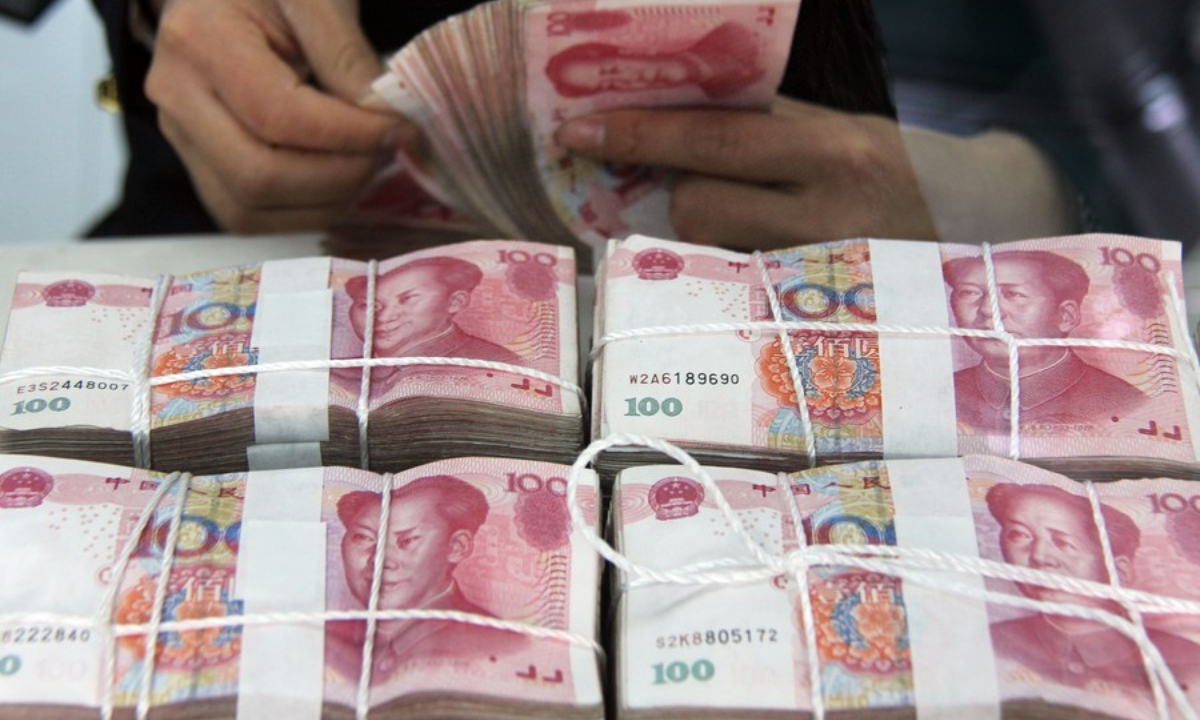
File photo shows a worker counts Chinese currency Renminbi banknotes at a bank in Tancheng County of Linyi City, east China's Shandong Province. Photo:Xinhua
The People's Bank of China (PBC), the country's central bank, announced recently that it has resumed its pledged supplementary lending (PSL) facility and injected 350 billion yuan ($49 billion) of liquidity into three policy banks, the first such move in almost a year.
The funds are expected to be used to support key economic sectors such as infrastructure and real estate, experts said on Wednesday, noting that the move signals China's proactive stance in implementing growth-stabilizing policies.
In December 2023, the China Development Bank, Export-Import Bank of China and Agricultural Development Bank of China collectively added a net total of 350 billion yuan in PSL. The outstanding amount of PSL loans stood at 3.25 trillion yuan as of the end of December, the central bank revealed on Tuesday.
The PBC did not disclose the specific sectors to which the newly added PSL will be allocated.
Established in 2014, the PSL is one of the central bank's monetary policy tools. Its primary role is to provide financial institutions with longer-term and low-cost financing, specifically aimed at supporting the national economy's key sectors and weak areas and fostering the development of social initiatives.
The last time the PBC used the PSL program was in February 2023, with an infusion of 1.7 billion yuan, according to media reports.
With a monthly addition of 350 billion yuan, this marks the third-highest monthly injection in the history of the PSL program, media outlet yicai.com reported.
Given that PSL funds have historically been mainly invested in real estate-related sectors, there is significant market attention as to what fields the loans will be directed, the report said.
The "Three Major Projects" under the new development model for the real estate sector - the construction of affordable housing, the development of "dual use" public infrastructure and urban renewal projects -- will need a substantial amount of medium- to long-term low-cost funding, Ming Ming, chief economist at CITIC Securities, told the Global Times on Wednesday.
This new round of additional PSL funds is expected to focus on investment in these sectors, with the scale possibly surpassing 350 billion yuan, Ming said, noting that subsequent PSL injections are likely.
Based on the experience during the 13th Five-Year Plan (2016-20), the leverage effect of PSL on project investments is about 1:2.5. The injection of PSL funds is expected to play a significant role in stabilizing growth, according to Ming.
"Assuming an addition of 500 billion yuan, it not only has the potential to drive an increase in annual social fixed-asset investment by 0.5 to 0.7 percentage points but also help to boost market sentiment," Ming said.
At this pivotal stage of China's economic recovery, the PBC is properly intensifying the use of the PSL facility, which is expected to alleviate financial pressure in specific sectors, stimulate effective investment, and promote employment and overall consumption, Zhou Maohua, a macroeconomic analyst at Everbright Bank, told the Global Times on Wednesday.
The resumption of the PSL facility sends a clear signal of a proactive stance by China in implementing growth-stabilizing policies, Zhou noted.
During the tone-setting Central Economic Work Conference held in December 2023 in Beijing, Chinese policymakers emphasized the need to accelerate the building of a new development model for the country's real estate sector.
Active and prudent efforts should be made to defuse risks in the property sector, and the reasonable financing needs of developers of different ownership types should be met. The construction of the "Three Major Projects" should be accelerated, the meeting noted.




